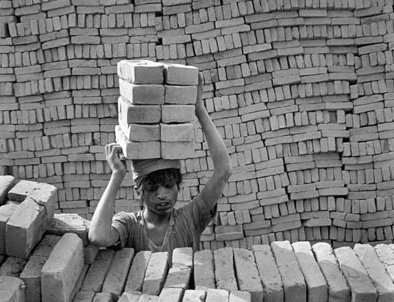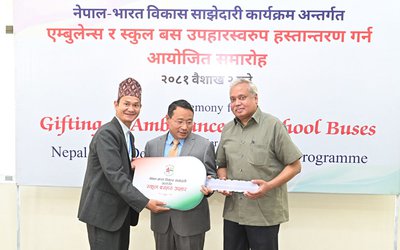
Dhan Bahadur Tamang, 14, collects the fares for a city bus. As a conductor, he often encounters problems while verifying the genuineness of the bearers of the college identity cards of his age.
Resident of Tinpiple of Nuwakot district, Tamang works almost 15 hours a day for less than Rs. 100.00 (one US dollar equivalent at the current exchange rate).
"This is better for me here in comparison to my life back home where I have to work more hours with less food to eat," said Tamang, a member of the marginalized community and a primary school dropout.
Among the ethnic groups living in Nepal's mid hills, the economic status of Tamang is lower than that of others. This increases their vulnerability and gets them into the trap of some worst forms of child labor and trafficking.
The ILO defines child labor as the work that deprives children of their childhood, education, potential and dignity, and work that is harmful to their physical and mental development. While governments have raised commitments to find new solutions to end exploitative work for children, the priority remains with the worst forms of child labor such as slavery, trafficking of children, debt bondage, forced or compulsory labor, use of children in armed conflict, prostitution, pornographic performances or illicit activities, and in particular, in the production and trafficking of drugs.
According to the Central Committee of Nepal Transport Workers Association (NTWA), out of 155,000 laborers working in the transport sector, more than 35,000 are children between nine to fifteen years of age.
The report reveals that most of these children spend their night in the vehicles and more than 80 percent of them do not have access to basic health services. Many of them are facing food and accommodation problem, some of them do not get medical treatment even in accidents.
"Child labor has been widespread in Nepal for many centuries, mostly in rural areas, as it is considered to be a part of the normal process of socialization. Children in the earlier days, and even today, have worked for as long as families have needed their support in the farms and in the fields. Doing this deprives them of their education, right to grow in a conducive environment, and have fun (especially because enjoying childhood is considered equally crucial for children's growth and mental and often physical development)," ILO sources say.
Despite legal restriction in the use of child labor, hundreds of children, at the age of Dhan Bahadur, have been working in the transport sector. This is a bitter reality for Nepal where thousands of children are suffering from various forms of child labor.
The Child Labor(Prohibition and Regulation) Act 2000 says, ''No child below sixteen can work and no child shall be engaged in work exceeding six hours a day and 36 hours a week whether by giving or not giving extra remuneration.”
Although Nepal has various laws governing the employment of children as an offence, they have not stopped the century old practice of child exploitation. Worse, in the total population of Nepal, only 54% Nepalese are educated.
Nepal has made enormous progress in the education sector and has promulgated a number of acts against child labor. However, an overwhelming number of children below 10 years is still illiterate and children above the age of 10 are found engaged in hazardous forms of child labor.
"We are aware about the situation. The government has been making efforts to reduce the child labor," said the spokesperson at the Ministry of Labor.
According to the survey, child labor occurs not only outside the home, but also inside it. In the urban areas, people keep children to keep their house clean. The same people do not give the children a chance for good education and good livelihood. In the rural areas, parents need help from their children to work in many household chores. While helping their parents, the children are being deprived of the opportunity to acquire education.
The National Master Plan on the Elimination of Child Laboraims to eliminate all worst forms of child labor by 2016 and all child labor by 2020. With co-operation from the government and non-government agencies, social partners and development partners, the government is showing its determination to implement the National Master Plan of Child Labor (NMP) 2011-20.
Although Nepal has made international commitments from a long time back to eliminate child labor, children like Dhan Bahadur have to wait for a long time to see any relief from their routine of working as child labor.
- Menstrual Hygiene
- Jun 09, 2014
- SENIOR CITIZEN: Nowhere To Go
- May 09, 2014
- PRISM: Poverty Reduction
- Apr 19, 2014
- Women's Rights: Continuing Fight
- Mar 09, 2014
- WATER AND SANITATION: Fluid Crisis
- Feb 15, 2014

















